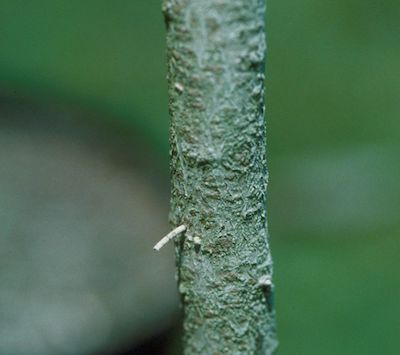Ambrosia Beetles — The Non-Native Ones are Worse
by Elaine Pugh, Fairfax Master Gardener

Ambrosia Beetle
When I was doing my research on the Ambrosia beetle, I found out that there are two different strains of the Ambrosia beetle — the native and the non-native ones. In their natural habitat, the native Ambrosia beetles only attack already-weakened trees. The non-native Ambrosia beetles, on the other hand, can attack healthy trees and shrubs as well. The healthy native trees have built up a natural immunity to the native Ambrosia beetle. These same healthy trees do not have an immunity to the non-native beetles.
I separated the articles, and a few months ago I wrote an article on the native Ambrosia beetle, “Ambrosia Beetles — the Hyenas of the Insect World.”
And now for the rest of the story.
Identification and Lifecycle
Xylosandrus crassiusculus, the non-native Granulate Ambrosia Beetle, previously known as the Asian Ambrosia Beetle, is a pest that can attack over 200 species of otherwise-healthy thin-barked deciduous trees and shrubs. Specifically, these beetles attack young trees and small branches of mature trees. Some common plants that may be attacked include dogwood, redbud, maple, ornamental cherry and crape myrtle. Others include peach and plum trees, Bradford pear, magnolia, azalea, redbud and hydrangea. The Granulate Ambrosia Beetle entered the U.S. in 1974 in Charleston, SC and spread into Virginia in 1992.

Larval and pupae of granulate ambrosia beetle
Like his cousin the native Ambrosia Beetle, the non-native Ambrosia Beetle is in a group of wood-boring beetles that share an unusual behavior called “fungus farming.” They breed on spores of symbiotic ambrosial fungi within tunnels bored deep into the tree. Once they are within the tree, they are difficult to control.
Granulate Ambrosia Beetles develop through four life stages: egg, larva, pupa and adult. The adult beetles are stout-bodied, dark reddish brown and darker red to blackish on top the rear. The female is about 2.5 millimeters long, and males are somewhat smaller. The larvae are white and legless with a dark head, and curl into a C shape if disturbed.
The female Granulate Ambrosia Beetles emerge in early spring and bore into small trunks and branches and excavate a network of tunnels into the heartwood where they lay their eggs. They inject symbiotic “ambrosia” fungi into the galleries to feed the developing larvae. The eggs, larvae and pupae stages occur within the tree. The females remain in the tunnels until the larva mature, and push pencils of frass out of the tunnels to maintain good conditions for the growth of the larvae. The new adult females then fly off to find additional tree hosts to infest. The males are flightless.
Damage
The branches and trunks attacked are usually 1 to 4 inches (2 to 10 cm) in diameter. Infestations are typically found below shoulder height on the tree, near ground level on saplings, or at bark wounds on larger trees.

Sawdust “toothpick” indicating beetle attack
Symptoms of an infestation include fragile, easily-broken and missing, pencil-like “toothpicks” of sawdust up to 1.5 inches (4 cm) in length pushed out of the tiny holes bored in the bark, frass at a branch joint, or frass on the ground.
Trees severely infested with Granulate Ambrosia Beetle may show symptoms of wilting, stunting, delayed leaf emergence in spring, pale foliage and premature leaf drop. Cankers may form at the site of the attack, sometimes resulting in the death of trees by girdling. Infestations commonly kill young trees. Serious attacks that result in the death of the tree usually occur during the leafing-out stage.
Infested plants often die from boring damage, Ambrosia fungus or infection by a secondary pathogen. In addition to boring damage, the Ambrosia fungus can block the internal arteries of the tree. The weakened tree is then susceptible to additional damage and death.
Management
Control After Infestation
Pyrethroids have been found to provide control from attacking Granulate Ambrosia Beetles, but only if applied before the galleries are closed with frass. Once the beetles are in the tree and have frass packed in the entry holes to seal them, they cannot be killed with insecticides. Fungicides are also ineffective against the Ambrosia fungus.
If the infestation is found on branches or the main trunk of the tree, the infected areas should be removed and destroyed. If the entire tree is not removed, any other obvious conditions causing stress to the tree should be corrected.
Preventative Measures
As a preventative measure, applications of pyrethroid insecticides can help protect trees by preventing the Granulate Ambrosia Beetles from boring galleries into the trees. According to the Alabama Extension Office, recent research shows the first flight of Granulate Ambrosia Beetles in spring occurs at almost exactly the same time as Bradford pears begin to bloom, and thus a good time to apply preventative sprays. Repeated spraying may be needed. According to Virginia Cooperative Extension, where Ambrosia beetles are commonly a problem, ethanol traps along the edge every 10 meters on sides facing the woods may reduce immigration pressure.
Other preventative measures include buying only pest-free plants from reputable local nurseries, purchasing and using firewood near where you will burn it (moving firewood commonly spreads pests) and proper maintenance to keep your trees in optimal health.
-
References
- Ambrosia Beetles Attacking Small Trees, Mallory Kelley, Alabama Cooperative Extension Office
- Granulate Ambrosia Beetle: Biology and Management, Shimat V Joseph, University of Georgia Extension
- Granulate-Ambrosia Beetle – A Threat to Ornamental Trees, University of California
- Ambrosia beetles and bostrichids, Virginia Tech
- Granulate Ambrosia Beetle, Featured Creatures, Thomas H. Atkinson, John L. Foltz, Robert C. Wilkinson, and Russell F. Mizell, University of Florida